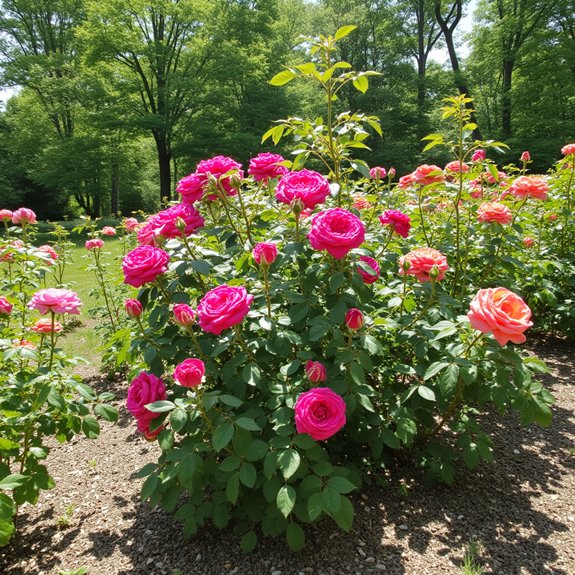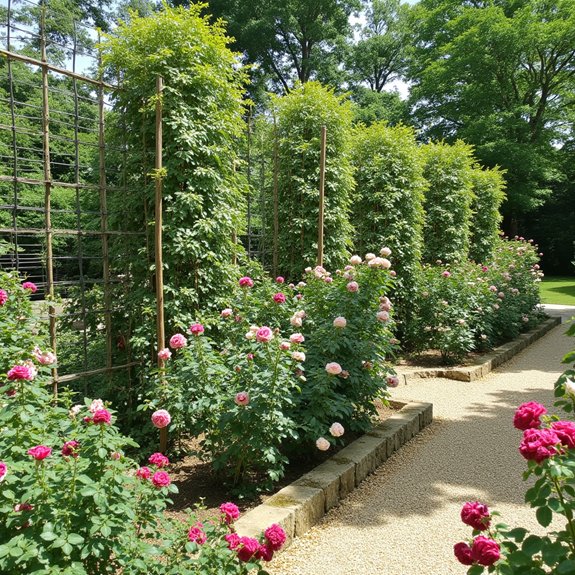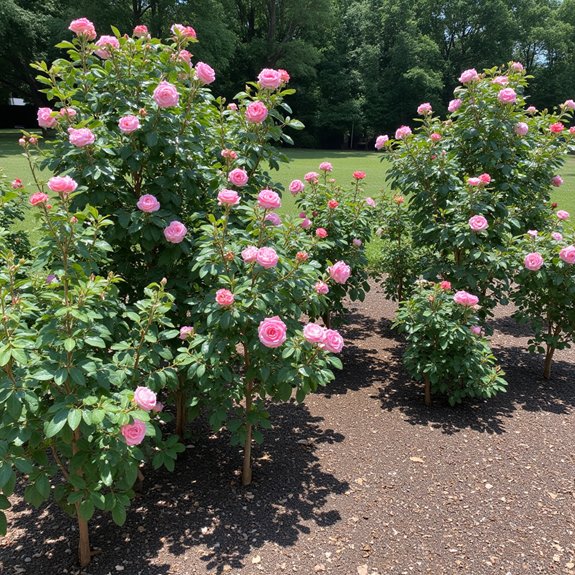You’ve probably dismissed growing roses in shaded spots, thinking they need blazing sun all day. That’s actually a costly misconception that’s keeping you from stunning blooms in those tricky, partially-shaded corners of your garden. Many rose varieties thrive with just 4-6 hours of morning sunlight, maintaining vibrant colors while requiring less water than their sun-soaked cousins. The secret lies in selecting the right cultivars and understanding their unique growing patterns.
Contents
- 1 Understanding Roses That Thrive in Partial Sunlight
- 2 Top Shade-Tolerant Rose Varieties for Your Garden
- 3 Growth Habits and Training Options for Shaded Roses
- 4 Color Selection and Visual Appeal in Low-Light Conditions
- 5 Watering Requirements for Roses in Shaded Areas
- 6 Disease Resistance Benefits of Shade-Growing Varieties
- 7 Fragrance Profiles of Shade-Loving Rose Cultivars
- 8 Seasonal Blooming Patterns and Maintenance Tips
Understanding Roses That Thrive in Partial Sunlight

While most gardeners assume roses need blazing sunshine to flourish, many varieties actually perform beautifully with just four to six hours of morning light. You’ll discover that shade benefits include better color preservation, as intense sunlight can fade delicate petals quickly. Your roses will require less frequent watering since shaded soil retains moisture longer than sun-exposed areas.
Light exposure timing matters most—morning sun energizes photosynthesis while afternoon shade protects from scorching heat. Floriferous varieties like polyanthas, floribundas, and shrub roses adapt exceptionally well to partial shade conditions, often producing abundant blooms despite reduced solar energy.
Top Shade-Tolerant Rose Varieties for Your Garden
When selecting roses for shadier garden spots, you’ll find exceptional performers that combine beauty with resilience. Iceberg offers versatile growth, reaching 4-15 feet with cotton-white blooms and excellent disease resistance. Madame Plantier thrives in zones 3-9, producing blushed ivory flowers with sweet fragrance. For compact spaces, Golden Unicorn stays 3-4 feet tall with vibrant blooms and fruity scent. Lyda Rose resembles pink dogwood, blooming spring through frost with sugared spice fragrance. Smart rose pairings include Lyda Rose with shade-loving ferns or Golden Unicorn with purple geraniums. These strategic gardening techniques maximize visual impact while ensuring healthy growth in partial sun conditions.
Growth Habits and Training Options for Shaded Roses

Understanding how these shade-tolerant varieties grow helps you maximize their potential in your garden space. Iceberg roses offer versatile training techniques, growing 4-15 feet as climbers or compact shrubs. You can train them against fences or trellises for vertical coverage.
Madame Plantier’s robust, rapid growth reaches 5-12 feet, requiring regular pruning for growth maintenance. Lyda Rose stays manageable at 4-5 feet, perfect for borders without extensive training.
Golden Unicorn’s compact 3-4 foot habit needs minimal intervention. Swamp Rose naturally sprawls 6-8 feet, thriving with minimal pruning in moist areas where other varieties struggle.
Color Selection and Visual Appeal in Low-Light Conditions
Since shaded gardens naturally mute bright colors, choosing the right rose hues becomes essential for creating stunning visual impact. Yellows, whites, pale pinks, and deep reds work exceptionally well in low-light conditions, maintaining their vibrancy longer than sun-exposed blooms.
Consider ‘Iceberg’s cotton-white ruffled flowers for crisp color contrast against dark foliage. ‘Arctic Blue’s light violet pink blooms create visual harmony with their white reverses, while ‘L.D. Braithwaite’s large crimson flowers provide dramatic punch.
Shaded conditions actually preserve rich colors longer, preventing the fading common in full sun. This natural color protection means your carefully selected roses maintain their intended beauty throughout the growing season.
Watering Requirements for Roses in Shaded Areas

While sun-loving roses demand frequent watering, shade-grown varieties actually require less attention at the hose. Shaded soil retains moisture longer than sun-exposed ground, meaning you’ll water less often. This reduced watering frequency saves time and prevents overwatering issues.
Check soil moisture by inserting your finger two inches deep. If it’s damp, wait another day or two. Roses like Swamp Rose thrive in consistently moist conditions, while others prefer moderate moisture levels.
When you do water, apply deeply at the base rather than sprinkling leaves. This encourages strong root development and reduces disease risk.
Disease Resistance Benefits of Shade-Growing Varieties
Beyond easier watering schedules, shade-growing roses offer another significant advantage: superior disease resistance. Many shade-friendly varieties naturally withstand common rose ailments that plague their sun-loving cousins. ‘Iceberg’ resists black spot and humid conditions, while ‘L.D. Braithwaite’ combines old-fashioned charm with modern disease resistance. ‘Arctic Blue’ withstands diseases that affect fragile varieties, and ‘Madame Plantier’ tolerates neglect beautifully.
These shade benefits make gardening simpler for you. You’ll spend less time treating fungal problems, applying sprays, or replacing diseased plants. Disease resistance means healthier roses with minimal intervention required.
Fragrance Profiles of Shade-Loving Rose Cultivars
Fragrance transforms any garden space, and shade-loving roses deliver an impressive array of scents that’ll surprise you with their intensity and variety. ‘Madame Plantier’ offers a strong, sweet scent that carries beautifully through shaded areas, while ‘Lyda Rose’ brings a distinctive sugared spice fragrance that’s both warm and inviting.
You’ll find fragrance intensity often increases in partial shade since cooler conditions preserve volatile oils longer. ‘Golden Unicorn’ contributes fruity notes, and ‘Arctic Blue’ adds citrus freshness to your scent combinations. ‘L.D. Braithwaite’ rounds out the palette with classic old rose perfume that lingers throughout evening hours.
Seasonal Blooming Patterns and Maintenance Tips
Those enticing fragrances reach peak intensity during specific blooming cycles, and understanding these patterns helps you maximize both scent and visual impact throughout the growing season. ‘Iceberg’ delivers its cotton-white flowers in an early spring flush, then continues with steady summer blooms that extend well into fall. ‘Madame Plantier’ concentrates its energy into weeks-long spring displays, creating dense clusters of blushed ivory flowers that perfume entire garden sections.
‘Lyda Rose’ maintains impressive blooming frequency from spring through frost, requiring minimal seasonal care. ‘Golden Unicorn’ produces heavy spring shows with occasional summer repeats, benefiting from deadheading spent blooms to encourage continued flowering.
